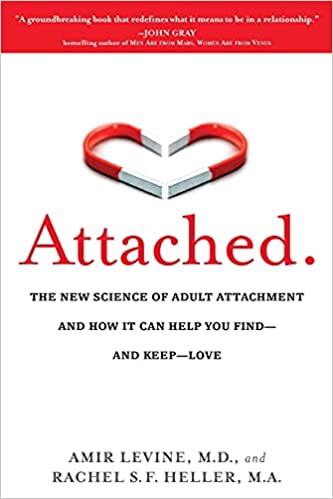Attached: The New Science of Adult Attachment — Book Summary
Introduction
This powerful author duo use psychological principles to explain a phenomenon we live with from infancy in this book. Using interesting examples, and easy to understand vocabulary, they manage to explain why attachment and human relationships are a basic need for human beings and why it is important to develop healthy attachments.
Interesting quotes from the book
Most people are only as needy as their unmet needs.
— Amir Levine, Attached: The New Science of Adult Attachment
Feeling close and complete with someone else -- the emotional equivalent of finding a home
— Amir Levine, Attached: The New Science of Adult Attachment
It's important to remember that even with effective communication, some problems won't be solved immediately. What's vital is your partner's response--whether he or she is concerned about your well-being, has your best interests in mind, and is willing to work on things.
— Amir Levine, Attached: The New Science of Adult Attachment
Summary of the book Attached: The New Science of Adult Attachment
This book discusses the attachment theory, which describes how people react to growing intimacy in relationships and how they react to things not going according to plan in the relationship. Partially formulated in the 60s by Mary Ainsworth and John Bowlby, the attachment theory was originally for studying attachment behaviour in infants, but Amir Levine applied the theory to adult relationships like he has done for years.
The first chapter begins by sharing three stories, all about different types of relationship problems. It then introduces the three attachment styles according to the attachment theory:
- the secure, who feel comfortable with intimacy and attachment, and are usually warm and loving;
- the anxious, who are often preoccupied with their relationships and tend to worry about their partner's ability to love them back;
- and the avoidant, who equate intimacy with a loss of independence and constantly try to minimize closeness.
The second chapter talks about how everyone needs attachment, contrary to the wrong presupposition that people didn't need attachment and people should be emotionally self-sufficient. It also talks about the co-dependency myth, which essentially says that happiness is something that should come from within and should not be dependent on a lover or mate. This myth was debunked with facts, with the book showing that we are genetically created in such a way that we need someone to be with, and that has nothing to do with how much we love ourselves or how fulfilled we are. We always choose someone to be attached to. But what about in situations whereby the person we chose doesn't fulfil his attachment role? The chapter touches on that a bit.
The third chapter talks in-depth about the three attachment styles and how you can know what attachment style you are. If a person is not sure about what attachment style he or she is, then there is a graph put there, where there can be a more accurate measure of the attachment styles that he or she has.
The next chapter begins to discuss how to deduce what kind of attachment style your partner is, whether anxious, avoidant, secure, or anxious-avoidant. It then attaches a sort of questionnaire that lets you know what kind of attachment styles your partner is in. There are some golden rules that help to determine what kind of attachment style your partner is. They are: determine whether s/he seeks intimacy and closeness, assess how preoccupied s/he is with the relationship and how sensitive s/he is to rejection; look for various signs; assess his/her reaction to effective communication; listen and look for what he or she is not saying or doing. As a sort of test, scenarios are given for the reader to consider and determine whether a person is avoidant, secure, or anxious.
The next chapter talks about the anxious attachment style, which generally has a super-sensitive attachment system. They are more vigilant to changes in their partner's emotions, and any slight change triggers them. When this happens, they are consumed by activating strategies, which are thoughts or feelings that compel a person to get close, physically or emotionally, to their partners when they sense changes. The anxious need to know how they work, and their best chance at a happy relationship is to be secure.
The next chapter discusses the avoidant attachment style in very full detail. In essence, if you have an avoidant attachment style, you always manoeuvre to keep people at a distance, whether you are single or involved in a relationship, even a committed one. They still need affection as much as anyone else, and so they are vulnerable in spite of the defensive shell they form around themselves, and in a period of emotional unguardedness such as depression or a divorce, they feel this vulnerability deeply. They push people away using 'deactivation techniques' such as not saying "I love you" back when they're told and so on. They also have many misleading thought patterns that lead to their avoidant behavior. The book then answers the question of whether avoidants can change and how they can change.
The next chapter talks about the secure attachment style in great detail. Secures are comfortable, and when they're in relationships with an insecure, the relationship still goes smoothly. They can be any type of person, whether friendly or introverted or anything else. They expect their partners to be loving and responsive and don't worry much about losing their partners' love, and, unlike avoidants, they do this even when emotionally unguarded. However, this doesn't mean that they're not also prone to having relationship problems, especially if they're in a relationship with an insecure. They may tolerate bad behavior in a relationship if they still feel that they're responsible for their partner's well-being. However, people can know when they're in a problematic relationship, and the book tells them how.
If the anxious and avoidant meet, how do they cope? The next chapter talks about the signs of an anxious-avoidant trap in a relationship and why this is often very difficult to resolve. But it is not impossible to do. Reminding anxious or avoidants of security-enhancing experiences they've had (or security 'priming') can help in making each partner feel secure.
In cases where an anxious-avoidant try becomes very bad, one or both partners must 'deactivate'.
The book then ends with how to choose the right partner that suits your attachment style, how to effectively communicate, and how to deal with conflict, teaching effective ways to do all these.
Key Lessons from the Book
Lesson 1: Note what kind of Attachment your partner has.
To further understand where conflict may be coming from between you and your partner, it's pertinent to understand your partner, and their attachment styles.
Lesson 2: It is perfectly okay to desire a relationship
Wanting a partner is nothing to be ashamed about. It is natural to humans to want the company of others. Rather than spend time being ashamed that you don't seem to be a ‘natural loner', spend time keeping yourself open for healthy relationships!
Lesson 3: Understand your Attachment Style
One of the best weapons you can go into relationships with is understanding what kind of attachment style you have. This will enable you to approach your partners in more productive ways, giving you a better experience with your relationships.
Lesson 4: Work on the flaws your Attachment Style may give.
As you understand what kind of attachment style you have, you will most likely begin to notice your flaws, this is no cause for alarm or to start feeling down. What you have to do is simply work on your flaws more, understanding that it might take time, and you will never be perfect.
Review of the book Attached: The New Science of Adult Attachment
I found the book quite riveting to be honest, I see why John Gray would leave a stunning review of the book. Of course, I lunge for anything that borrows from psychology. This book is no different. It further proves that the best way to understand people is to find out what makes them act the way they do.
Conclusion
I honestly think we could all learn from this book. Finding strength in vulnerability can be hard for most of us, but there's no harm in admitting we need other people and relationships. I think the people who would especially benefit from this book are married couples. Turn a page and learn more about each other!
Don't miss the other book summaries on SunInMe.org

